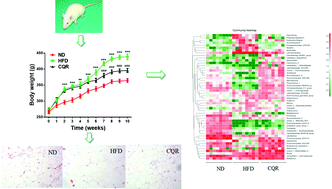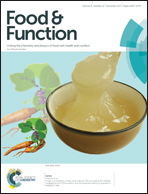A combination of quercetin and resveratrol reduces obesity in high-fat diet-fed rats by modulation of gut microbiota†
Abstract
Resveratrol and quercetin, widely found in foods and vegetables, are plant polyphenols reported to have a wide range of biological activities. Despite their limited bioavailabilities, both resveratrol and quercetin are known to exhibit anti-inflammation and anti-obesity effects. We hypothesized that gut microbiota may be a potential target for resveratrol and quercetin to prevent the development of obesity. The aim of this research was to confirm whether a combination of quercetin and resveratrol (CQR) could restore the gut microbiota dysbiosis induced by a high-fat diet (HFD). In this study, Wistar rats were divided into three groups: a normal diet (ND) group, a HFD group and a CQR group. The CQR group was treated with a HFD and administered with a combination of quercetin [30 mg per kg body weight (BW) per day] and resveratrol [15 mg per kg body weight (BW) per day] by oral gavage. At the end of 10 weeks, CQR reduced the body weight gain and visceral (epididymal, perirenal) adipose tissue weight. Moreover, CQR also reduced serum lipids, attenuated serum inflammatory markers [interleukin (IL)-6, tumor necrosis factor (TNF)-α, monocyte chemotactic protein (MCP)-1] and reversed serum biochemical parameters (adiponectin, insulin, leptin, etc.). Importantly, our results demonstrated that CQR could modulate the gut microbiota composition. 16S rRNA gene sequencing revealed that CQR had an impact on gut microbiota, decreasing Firmicutes (P < 0.05) and the proportion of Firmicutes to Bacteroidetes (P = 0.052). CQR also significantly inhibited the relative abundance of Desulfovibrionaceae (P < 0.01), Acidaminococcaceae (P < 0.05), Coriobacteriaceae (P < 0.05), Bilophila (P < 0.05), Lachnospiraceae (P < 0.05) and its genus Lachnoclostridium (P < 0.001), which were reported to be potentially related to diet-induced obesity. Moreover, compared with the HFD group, the relative abundance of Bacteroidales_S24-7_group (P < 0.01), Christensenellaceae (P < 0.001), Akkermansia (P < 0.01), Ruminococcaceae (P < 0.01) and its genera Ruminococcaceae_UCG-014 (P < 0.01), and Ruminococcaceae_UCG-005 (P < 0.01), which were reported to have an effect of relieving HFD-induced obesity, was markedly increased in the CQR group. Overall, these results indicated that administration of CQR may have beneficial effects on ameliorating HFD-induced obesity and reducing HFD-induced gut microbiota dysbiosis.



 Please wait while we load your content...
Please wait while we load your content...